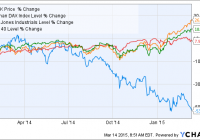3 Looks At Current Market Multiples
Summary The S&P 500 has come of its all-time high, down 9% from its May peak. This article puts the current level in historical context by examining three different earnings multiples. Trailing 1-year earnings, estimated forward 1-year earnings, and a measure of cyclically-adjusted price/earnings are used to frame the current market level. I leave readers with three takeaways on my views of this data. When the S&P 500 (NYSEARCA: SPY ) was hitting new all-time highs in early 2015, I authored an article entitled ” A View From the Top: 3 Looks at Market Multiples “. Given the recent market pullback, this article reprises these different views to put the market drawdown in context. This article looks at the current price level of the index via three different measures: 1) a historical examination of the index relative to trailing one-year earnings; 2) a historical examination of the index relative to forward one-year earnings; and, 3) a historical examination of the cyclically adjusted price earnings multiple. (Source: Standard and Poor’s; Bloomberg) The graph above shows the most commonly cited earnings multiple, the Price/Earnings (P/E) ratio, which shows the index level relative to trailing one-year earnings. When I wrote a version of this article in February, the market was valued at roughly eleven percent more than its average since the broad market gauge went to its current five-hundred constituent form in 1957. With the recent pullback, we are trading at just a 1.6% premium to the market’s historical multiple. (Source: Standard and Poor’s; Bloomberg) The second graph shows the current index level relative to a best estimate of forward earnings from Bloomberg. Based on the current expectation of continued strong growth in earnings, the index is valued at 16.2x forward earnings. In February, this valuation was 6.5% greater than the trailing 25-year average, which is the extent of the ratio history available on Bloomberg. Today, the market is actually trading at a small discount of 2.7% relative to this historical valuation multiple. (click to enlarge) (Source: Robert Shiller ) While we often talk about valuation relative to trailing or forward one-year earnings, as we did in the previous two sections, examining the index level relative to earnings over a length of time more consistent with an entire business cycle can be viewed as more appropriate. Above is a version of Yale economics professor and Nobel laureate Robert Shiller’s cyclically adjusted price-to-earnings ratio (CAPE or Shiller P/E), a valuation measure applied to the equity market that divides the price level of the index by the average of ten years of earnings, adjusted for inflation. With the index multiple now roughly equivalent to the post-crisis market peak in 2007, and trailing only the historic bubbles in 1929 and 2000, the CAPE is the most oft-cited reason for lowered forward return expectations in the domestic equity market. The current multiple is 46% above its trailing 144-year average. Three takeaways: When I wrote a version of this article in early 2015, the valuations looked stretched by all three measures. In my article, ” 10 Themes Shaping Markets in 2015 “, I wrote: “Stretched equity multiples domestically will necessitate that valuations be driven by changes in earnings, tempering further price gains”. Well, we have not received price gains, with the S&P 500 producing a -6.7% return in 2015. This reduction in the index level has outpaced lower earnings from the commodity-sensitive sectors of the market, making the current market valuation appear more fair. Low interest rates have contributed to higher market multiples. In the CAPE graph above, notice that the market multiple moves inversely to the long-term interest rate level. With interest rates in the U.S. again rallying with increased macro volatility, market multiples have expanded. I covered this relationship in the 2012 article, ” Equity Multiples and Interest Rates: Is the Current Risk Premium Sufficient? ” Common stock valuation techniques include discounting future earnings back to the present, which demonstrates why lower (higher) interest rates would be consistent with a higher (lower) equity multiples. Low interest rates and near-zero short-term interest rates have pushed investors from cash and fixed income into more risky asset classes, which has also driven equity multiples higher. As rates began selling off in the taper tantrum in mid-2013, it felt like rate-driven equity gains could be peaking. With long Treasuries again rallying, and the Fed signaling to the market that they are likely to move slowly even if they move the Fed Funds rate higher, perhaps this upward pressure on valuations could stick around. 16.5 still looks to be a magic number. In all three of these valuation measures, which feature different perspectives and time horizons, the average market multiple has been around 16.5x (16.19x forward earnings multiple; 16.63x CAPE; 16.96x trailing earnings multiple). Over extended time horizons, elevated earnings multiples above 16.5x are going to be consistent with below-average forward returns. Conclusion In February, these three multiples signaled that the market was rich. After our first correction in several years, the valuations now appear more fair, although the CAPE multiple is still historically elevated. Shortening the lookback period in the CAPE multiple from ten years to five years strips out the 2008-2009 downturn, and the multiple is just 28% above its historical average. Readers must ascertain whether they believe that a proper risk premium is being reflected in this market valuation, and where they believe earnings growth is headed in the context of their own risk tolerance and portfolio construction. Disclosure: I am/we are long SPY. (More…) I wrote this article myself, and it expresses my own opinions. I am not receiving compensation for it (other than from Seeking Alpha). I have no business relationship with any company whose stock is mentioned in this article.
